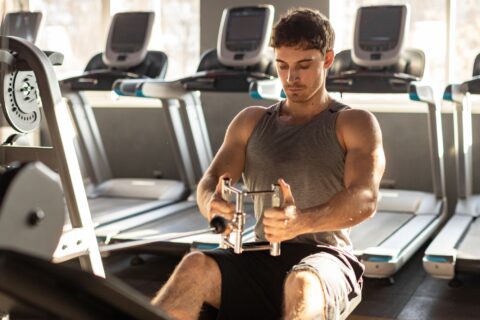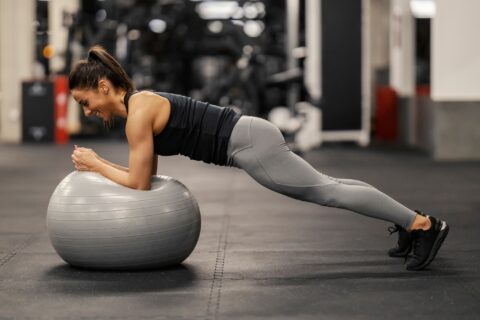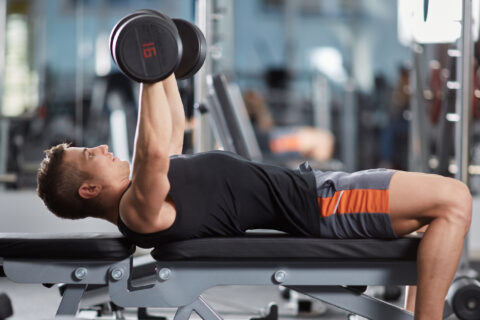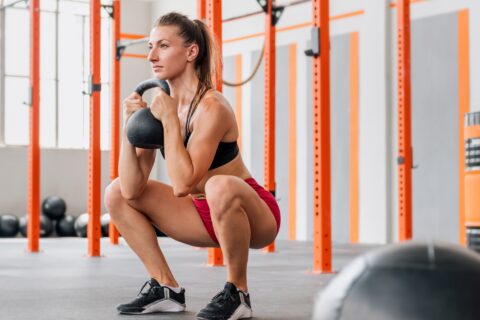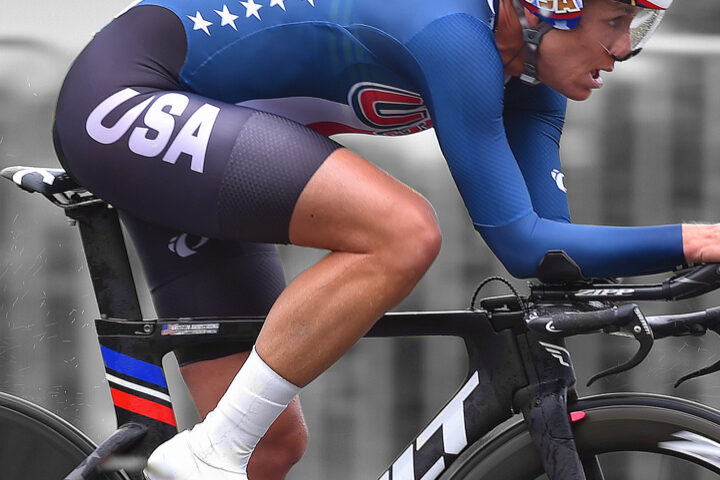Strength and conditioning coach Jess Elliott of TAG Performance has worked with many endurance athletes. She often sees similar issues when it comes to their strength and conditioning.
In this series of full-body movements, Elliott walks through a multi-planar approach to strength to address the specific weaknesses that she so often sees. The goals are to build stability, efficiency, and resilience.
“My priority isn’t simply sport performance,” Elliott said. “I’m looking at developing overall movement quality and patterns of movement, force generation and absorption, muscle sequencing and activation, muscle balance, and core/positional integrity. This is about learning how to move well for life.”
Building resilience in the lower body is crucial for athletes who bike and run a lot, while improving balance assists with our confidence on the bike by managing our center of mass. Improving unilateral movements is great for those times when we are climbing out of the saddle or running on trails.
Of note, there’s no sophisticated equipment necessary to perform these exercises. For those athletes who want to try the advanced progressions, you’ll want to have sliders, a dumbbell or kettle bell, and a pillow or mat handy.
For more on preventing injuries through strength and conditioning, check out Fast Talk Episode 87: Preventing Injuries Through Strength and Conditioning, with Jess Elliott.
Off-Season Exercises
The lower body pushing and pulling in these exercises places a greater emphasis on pulling to reduce injury risk due to quad:hamstring strength ratio, and to improve hip stability.
Between this selection of movements and the core workout video, Strength and Conditioning: Core Exercises for Cyclists, this is a well-balanced program that can be performed at home with minimal equipment.
This isn’t “sexy” training; it’s essential training that all endurance athletes need and very few perform correctly. These movements (and variations of them) are perfect for beginners and pros alike.
Leg Curls
- Equipment: stability ball, sliders, small towel, paper plates
- Benefits:
- knee dominant lower body pull
- many progressions/regressions
- scalable, bilateral, or unilateral emphasis
- Start with 5-10 repetitions per leg (or total if starting double leg), progressing to 2-3 sets
Bent-Over Row
- Equipment: backpack, dumbbells, kettle bells, bands
- Benefits:
- horizontal upper body pulling
- unilateral or bilateral variations
- reinforces hinge position at the hips
- core integrity
- Start with 5-10 repetitions of moderate weight per side, progressing to 2-3 sets
Reverse Slide Lunge (with regressive or progressive variations)
- Equipment: hand towel, paper plate, slider, socks
- Benefits:
- lower body pushing and pulling
- better transfer to cycling and pedal stroke
- posterior chain emphasis
- more control over positioning
- unilateral emphasis
- great for barefoot training
- Start with 5-10 repetitions per side, progressing to 2-3 sets
Single Leg RDL (Romanian Deadlift)
- Equipment: backpack, dumbbells, kettle bells
- Benefits:
- hip dominant lower body pull
- balance
- unilateral emphasis
- great for barefoot training
- Start with 5-10 repetitions per leg, progressing to 2-3 sets
Video Transcript
Chris Case 00:01
Hey everyone, welcome to Fast Talk Laboratories, your source for the science of cycling performance.
Ryan Kohler 00:10
Hey everybody, head coach Ryan Kohler here with strength conditioning coach, Jess Elliot of TAG performance. And today she’s going to show you some essential off season strength exercises that are full body and require very little equipment. So you can find a lot of the stuff you need right at your home. So one of the other nice things of this these workouts we’re doing today is that we’re going to have our starting point for the movement, and then we’ll also have options to regress the movement if we need to make it a little bit easier or progress the movement if we need to make something a little bit more advanced. So you’ve got a range of options here, and one of the nice things I like from this routine is that we focus on very specific muscle groups. And it’s not just do this movement, and we don’t care what your body looks like. But there is some nice focus on activating specific muscles, because we can take that over to our cycling and really focus, same thing on the fundamental movements. So instead of using speed to sort of mask our progress on the bike, or using extra weight, to mask our progress with the strength exercises, we can have that focus on, get the fundamentals down, and then very gradually progress and don’t rush anything.
A Variation of Leg Curls
Jess Elliot 01:21
For this movement, we are going to showcase a variation of leg curls. So we’re going to be doing them bilaterally, so that’s both legs, and we’re also going to show unilateral variations and single leg variations, as well. So for these, Chris is going to be demonstrating using some sliders. For those of you who don’t have sliders at home, if you have like just a nice smooth floor like this, you can actually use hand towels in place of fancy sliders. Alright, so for the first variation, and the easiest variation, we’re just going to be working on the extension part of the leg curl. So to start, he’s going to bring his feet in just a little bit closer, and then he’s going to lift the hips. So we want to make sure there’s a nice straight line from the knees all the way to the shoulders. Now he’s going to take five counts to extend the legs out as slowly as he can. So 1,2,3,4,5 then he’s going to drop the hips all the way down to the ground, and then he’s going to reset the movements. So he’s just working on the eccentric part, which is the lengthening of the hamstrings for this movement. So we’ll showcase one more. So hips up, notice the toes are pulled up, that’s going to activate more of the posterior chain, some more of the hamstrings and the glutes. Five counts to extend 1,2,3,4,5 he’s going to drop the hips, slide them back into reset. Alright, so that’s the easiest variation just working on the eccentric component. Now, once you have enough strength, you can combine that with the consented movement, which is the muscle shortening. This is traditionally what we think of when we think of a leg curl. So, Chris is going to execute the same movement. Good. So he’s up on his heels, toes are pulled up towards the sky, nice straight line from knees all the way to shoulders, he’s going to slowly extend out, it doesn’t have to be a five count just nice and controlled. And then he’s going to take account to come all the way back in to perform the leg curl, so that’s the concentric part of the movement, where the hamstring is going to be shortening. Alright, so those are going to be our bilateral variations.
Leg Curl Variation in a Unilateral Format
Jess Elliot 03:18
Now we’re going to run the same variations in a unilateral format. So emphasizing single leg training. All right, Chris. So pick your favorite leg, or your least favorite leg, whichever works best. So we’re gonna start with the eccentric only, same thing. So we’re gonna take five counts to extend out. So he’s gonna do a single leg, one leg is going to stay extended, so thighs main parallel, good. Nice, slow count out to extend, and then he’s going to drop the hips, pull the foot back into reset, so he’s giving himself a little bit of a break. Let’s try that one more time just to show single leg. Good, lift those hips, and we’re just doing the eccentric component. Good, so nice, slow extension, drop the hips, and will reset.
Leg Curl Variation Using Sliders
Jess Elliot 04:00
All right, now if you’re feeling really ready to challenge things, you’re going to do the eccentric, but you’re also going to add in the single leg leg covariation using the sliders. Alright, Chris you feeling ready? Alright, so he’s going to extend one leg straight out, he’s going to lengthen first. Then when he’s ready, he’s going to curl back in for the concentric part of the movement. So as you can see, this takes a considerable amount of strength. So you don’t necessarily want to start with the most challenging variation. Start with the eccentric bilateral variation, then work into concentric. When you have both legs pretty solid, then you can work through the unilateral variations. And this is how we perform the leg curls using the sliders.
A Single Arm Row Using a Kettlebell
Jess Elliot 04:43
So we’re going to showcase an upper body pulling movement, this variation we’re going to showcase unilaterally so using one arm and we’ve got a little kettlebell here to help us out. So for this, Chris is going to start in a standing position. It’s going to take a slight bend at the knees. He’s going to reach the hips back into a nice hinge position. Beautiful. So we’re aiming for a nice flat back from the top of the head all the way down to the hips. Good. So he’s gonna start holding the kettlebell, you can also use a dumbbell, if you don’t have some formal weights, you can also use a backpack at home. Now what I want you to do, Chris, your elbows kind of winging out to the side, so I just want you to tuck that elbow tight to the body. Good. And so notice that his core is staying nice and stable, he’s not twisting from one side to another, he’s not doing that typical lawnmower start, whereas he’s reaching down, he’s twisting through the shoulders, everything is staying nice and stable. And then when he’s ready, he can just stand up, or he can transition switch to the opposite side with the weight. Good. And he’s using his hand kind of on his abdomen just for a little bit of support and for a little bit of cueing, as opposed to resting his hand on his leg, because we don’t want to actually brace against his body for support here. And this is how you perform a single arm row using a kettlebell or dumbbell.
Reverse Slide Lunge
Jess Elliot 06:05
For this next movement, we’re going to showcase a reverse slide lunge. So it’s a lunge variation, but by using the slide actually functions as lower body pushing movement and a lower body pulling movement. And what’s nice about this is because it’s a unilateral variation, as opposed to bilateral, so going off with two feet, that means that we’re taking away any sort of compensations that can happen as far as favoring one dominant side versus the other. Alright, so Chris is going to start in a standing position. So he has one leg stationary on the ground, so about 90% of his weight is going to be in this foot, about 10 to 20% is going to be on the sliding leg. Okay, so from here, he’s going to stand nice and tall, so head up straight, good. And he’s going to push and slide, this leg straight back, he’s going to keep going until this knee reaches 90 degrees, so tall through the torso. Good. So right there, we want to hit 90 degrees. So the knee is stacked directly over the ankle, and everything’s pointed forward. His leg is going straight back, it’s not kicked off to the diagonal, and now he’s going to initiate the lower body pulling portion of the movement where he slides to return back up to standing. So let’s do one more repetition a little bit faster. So he’s going to slide and push that back. Good, maintain an upright torso position nice and stable, and then when he’s ready, he’s going to pull to slide it back up, and this is how you perform a reverse slide lunge.
Romanian Deadlift
Jess Elliot 07:37
For this final movement, we’re going to be doing a single leg RDL, stands for Romanian deadlift or straight leg deadlift. But you can also call this inverted hamstring. So for this movement, he’s going to start by standing on one leg, and then yup, if you need to balance you can feel free to reach out, grab a shoulder. So this is going to be a lower body pulling movement, emphasizing the posterior chain, primarily, the hamstring and the hips of the standing leg. Alright, so he’s standing on his left side. So he’s got a slight bend at the knee, so we don’t want to be locked out. his right foot is hovering off the ground. And as his torso comes down, he’s going to slowly lift the back leg up off the grounds, and then come back up. So we’re going to reset we’re going to do a couple reps here. So balance is definitely essential. So you want to not walk out the knee. Good, and you don’t want to squat into this, good. So slightly bend the rest of this is going to be coming from the hips, and then use the hamstring glute to slowly extend back up through this legs, so we’re working on hip extension of the standing leg. Still a couple more reps if you want, you can change up sides, good. So I want you to think about the body kind of like a seesaw when you’re going through this movement. So as the torso comes down, that back leg is going to come up to counterbalance. So you don’t want the back leg to get stuck on the ground as the torso is laying down, because otherwise you’re going to look like you’re bent in half. So once again, head to heel, strong as steel, you want a nice straight line all the way from ears to angles, good and to extend from the hips, he’s going to use the hamstrings and the glutes. The big thing we don’t want to see here is pulling with the lower back to return to that standing position. So only lower as far as you can with control. Ideally, we want to see you parallel to the ground, it’s okay if you can’t get there on your first couple of tries. That’s something that you can work to as you become more comfortable with this movement as and as your balance improves, and this is how we do a single leg RDL.
Chris Case 09:34
As always, we love your feedback. So join us and join the conversation at forums.fasttalklabs.com to discuss all of what you’ve heard today and so much more.

